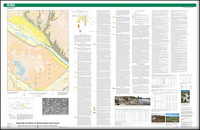Geologic map of the Weldona 7.5' quadrangle, Morgan County, Colorado
Links
- Sheets:
- Related Works:
- Scientific Investigations Map 3331 — Geologic map of the Orchard 7.5' quadrangle, Morgan County, Colorado
- Scientific Investigations Map 3344 — Geologic map of the Masters 7.5' quadrangle, Weld and Morgan Counties, Colorado
- Scientific Investigations Map 3408 — Geologic map of the Fort Morgan 7.5' quadrangle, Morgan County, Colorado
- Scientific Investigations Report 2019-5020 — Pleistocene and Holocene Landscape Development of the South Platte River Corridor, Northeastern Colorado
- Data Releases:
- USGS data release - Data release for the geologic map of the Weldona 7.5' quadrangle, Morgan County, Colorado
- USGS data release - Data release of OSL, 14C, and U-series age data supporting geologic mapping along the South Platte River corridor in northeastern Colorado
- Read Me: Read Me (8.0kB txt)
- Download citation as: RIS | Dublin Core
Abstract
The Weldona 7.5′ quadrangle is located on the semiarid plains of northeastern Colorado, along the South Platte River corridor where the river has incised into Upper Cretaceous Pierre Shale. The Pierre Shale is largely covered by surficial deposits that formed from alluvial, eolian, and hillslope processes operating in concert with environmental changes from the Pleistocene to the present. The South Platte River, originating high in the Colorado Rocky Mountains, has played a major role in shaping surficial geology in the map area, which is several tens of kilometers downstream from where headwater tributaries join the river. Recurrent glaciation (and deglaciation) of basin headwaters has affected river discharge and sediment supply far downstream, influencing deposition of alluvium and river incision in the Weldona quadrangle. During the Pleistocene the course of the river within the map area shifted progressively southward as it incised, and by late middle Pleistocene the river was south of its present position, cutting and filling deep paleochannels now covered by younger alluvium. The river shifted back to the north during the late Pleistocene. Kiowa and Bijou Creeks are unglaciated tributaries originating in the Colorado Piedmont east of the Front Range that also have played a major role in shaping surficial geology of the map area. Periodically during the late Pleistocene, major flood events on these tributaries deposited large volumes of sediment at their confluences, forming a broad, low-gradient fan of sidestream alluvium that could have occasionally dammed the river for short periods of time. Eolian sand deposits of the Sterling (north of river) and Fort Morgan (south of river) dune fields cover much of the quadrangle and record past episodes of sand mobilization during times of prolonged drought. With the onset of irrigation and damming during historical times, the South Platte River has changed from a broad, shallow, and sandy braided river with highly variable seasonal discharge to a much narrower, deeper river with braided-meandering transition morphology and more uniform discharge.
Suggested Citation
Berry, M.E., Taylor, E.M., Slate, J.L., Paces, J.B., Hanson, P.R., and Brandt, T.R., 2018, Geologic map of the Weldona 7.5′ quadrangle, Morgan County, Colorado: U.S. Geological Survey Scientific Investigations Map 3396, 1 sheet, scale 1:24,000, https://doi.org/10.3133/sim3396.
ISSN: 2329-132X (online)
Study Area
| Publication type | Report |
|---|---|
| Publication Subtype | USGS Numbered Series |
| Title | Geologic map of the Weldona 7.5' quadrangle, Morgan County, Colorado |
| Series title | Scientific Investigations Map |
| Series number | 3396 |
| DOI | 10.3133/sim3396 |
| Publication Date | March 21, 2018 |
| Year Published | 2018 |
| Language | English |
| Publisher | U.S. Geological Survey |
| Publisher location | Reston, VA |
| Contributing office(s) | Geosciences and Environmental Change Science Center |
| Description | Map: 54.85 x 37.32 inches; 4 Related Works; 2 Data releases; Read Me |
| Country | United States |
| State | Colorado |
| County | Morgan County |
| Online Only (Y/N) | Y |


